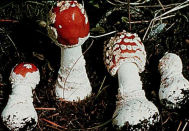Polypeptide Toxins in Amanita Mushrooms:
All of the toxins found in the Amanita spp. mentioned in this poisonous plants list are peptides. The distribution of the peptides varies in the different parts of the mushroom, with the cap being the most deadly part. The amatoxins, phallotoxins, and virotoxins are found in A. bisporigera, A. ocreata, A. phalloides, A. phalloides var. alba, A. suballiacea, A. tenuifolia, A. virosa, and some other mushrooms. The phallolysins are a recently discovered group of toxins as yet only seen in A. phalloides. Ibotenic acid is found in A. cothurnata, A. muscaria var.formosa, A. muscaria var.muscaria, and A. pantherina.
Amatoxins
There are nine amatoxins:
- alpha-Amanitin
- beta-Amanitin
- gamma-Amanitin
- epsilon-Aminitin
- Amanin
- Amanin amide - only found in A. virosa
- Amanullin
- Amanullinic acid
- Proamanullin
Amatoxins are solely responsible for fatal human poisonings. They are bicyclic octapeptides which are much more potent than any of the other toxins. The amatoxins are taken up by the liver where they begin to cause damage. They are then secreted by the bile into the blood where they are taken up by the liver again, causing a cycle of damage and excretion. In the liver, amatoxins inhibit RNA-polymerase II. The liver is slowly destroyed and is unable to repair itself due to the inactivation of the RNA-polymerase. Thus, the liver slowly dissolves with no hope of repair.
Phallotoxins
There are seven naturally occurring phallotoxins:
- Phalloin
- Phalloidin
- Phallisin
- Prophalloin
- Phallacin
- Phallacidin
- Phallisacin
The phallotoxins are all derived from the same seven amino acid cyclic
peptide backbone. There are two groups of phallotoxins, neutral and acidic.
The neutral phallotoxins contain D-threonine, while the acidic ones contain
beta-hydroxy-succinic acid.
Phallotoxins destroy liver cells by disturbing the
equilibrium of G-actin with F-actin, causing it to shift entirely to F-actin.
This leads to numerous exvaginations on the liver cell's membrane which
render the cell susceptible to deformity by low-pressure gradients, even
those of the portal vein in vivo. This is folowed by loss of potassium
ions and cytoplasmic enzymes which leads to depletion of ATP and glycogen
causing the final downfall of the liver.
Virotoxins
There are six virotoxins:
- Viroidin
- Desoxoviroidin
- Ala1-viroidin
- Ala1-desoxoviroidin
- Viroisin
- Desoxoviroisin
Although they have the same toxicological effects as and appear to be derived from the phallotoxins, the virotoxins are monocyclic heptapeptides, not bicyclic peptides.
Phallolysins
There are three phallolysins that are hemolytically active proteins, but, as previously stated, they are heat and acid labile and do not pose a threat to humans.
Ibotenic acid/Muscimol
Ibotenic acid is an Excitatory Amino Acid (EAA) and muscimol is its derivative. These toxins act by mimicking the natural transmitters glutamic acid and aspartic acid on neurons in the central nervous system with specialized receptors for amino acids. These toxins may also cause selective death of neurons sensitive to EAAs.
The Toxic Amanita spp:
The toxicity of the mushrooms on this list is certain; however, there are many others in the Amanita family which have not been positively identified as poisonous or nonpoisonous, please exercise caution in eating any of the these mushrooms.

A. bisporigera
This mushroom is one of a few species known commonly as "Destroying Angels" (A. virosa A. ocreata A. suballiacea A. tenuifolia ). It is smaller than A. virosa , but just as deadly. The only sure way to tell these Destroying Angels apart is by examination of their spores. Their similarity is also a good way to identify mushrooms to avoid: WHITE cap, WHITE gills, WHITE spores, ring and volva = DON'T EAT!! The toxins of this mushroom cause liver and kidney damage and death.
Identification:

A. cothurnata
This mushroom is also known as the Booted Amanita. It is a smaller variety of A. pantherina with a more whitish cap,but similarly poisonous. This mushroom may also be known as A. pantherina var. multisquamosa.
Identification:

A. muscaria var.formosa
This mushroom, the Yellow-orange Fly Agaric is closely related to A. muscaria var. muscaria. Its toxins are not fatal, but can cause sweating, deep sleep and disorientation.
Identification:

A. muscaria var.muscaria
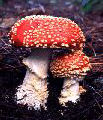
Photo courtesy of Nathan Wilson; nathan@d2.com
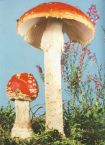
This mushroom, the Fly Agaric is closely related to A. muscaria var. formosa . Its toxins are not fatal, but can cause extreme sweating, delerium and raving. Don't be tricked into drinking the urine of someone who has eaten this mushroom to experience visions- it does not produce the same hallucinogenic effects that its Russian relative does!
Identification:


Photo courtesy of Dan Brown
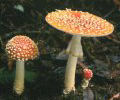
Photo courtesy of Dr. Dennis Desjardin

A. ocreata
This mushroom is another of the "Destroying Angels" (A. tenuifolia , A. suballiacea , A. virosa , A. bisporigera . It is just as deadly as the rest of them. The only sure way to tell these Destroying Angels apart is by examination of their spores. Their similarity is also a good way to identify mushrooms to avoid: WHITE cap, WHITE gills, WHITE spores, ring and volva = DON'T EAT IT!! The toxins of this mushroom cause liver and kidney damage, and death.
Identification:

A. pantherina

This mushroom is commonly known as the Panther. It is related to A. cothurnata and its toxin causes comalike sleep, delerium and raving.
Identification: :

A. phalloides
This mushroom is the famous Death Cap. The first of the Amanita toxins, phalloidin, was discovered in this mushroom by Lynen and Ulrich Wieland in 1938. This is not to say that it is not possessed of the truly dangerous amatoxins found in the Destroying Angels. The white Death Cap is a rare variety of A. phalloides, known as A. phalloides var. alba (also referred to as A. phalloides var. verna or A. verna ). Besides being nauseating in odor, these are both very deadly mushrooms, quite capable of causing death through liver and kidney failure.
Identification:

A. phalloides var. alba
This mushroom is commonly known as the Death Cap. This white Death Cap is a rare variety of A. phalloides. Besides being nauseating in odor, these are both very deadly mushrooms, quite capable of causing death through liver and kidney failure due to the bicyclic octapeptide, alpha amanitin.
Identification:

A. suballiacea
Identification:
The description for this mushroom is just about the same as that of A. tenuifolia. It is another white mushroom that falls into the Destroying Angel family (A. virosa , A. bisporigera , A. ocreata , A. tenuifolia ). Not much is known about it, but I wouldn't eat it.

A. tenuifolia
This mushroom is one of a few species known commonly as "Destroying Angels" (A. virosa , A. suballiacea , A. bisporigera , A. ocreata ). The only sure way to tell these Destroying Angels apart is by examination of their spores. Their similarity is also a good way to identify mushrooms to avoid: WHITE cap, WHITE gills, WHITE spores, ring and volva = DON'T EAT!! The toxins of this mushroom cause liver and kidney damage and death.
Identification:

A. verna

Photo courtesy of Dan Brown
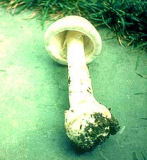
Photo courtesy of Dan Brown
This mushroom is one of a few species known commonly as "Destroying Angels" (A. tenuifolia, A. virosa A. suballiacea , A. bisporigera , A. ocreata ). The only sure way to tell these Destroying Angels apart is by examination of their spores. Their similarity is also a good way to identify mushrooms to avoid: WHITE cap, WHITE gills, WHITE spores, ring and volva = DON'T EAT!! The toxins of this mushroom cause liver and kidney damage and death.
Identification:

A. virosa
This mushroom is another of a few species known commonly as "Destroying Angels" (A. tenuifolia , A. suballiacea , A. verna , A. bisporigera , A. ocreata ). The only sure way to tell these Destroying Angels apart is by examination of their spores. Their similarity is also a good way to identify mushrooms to avoid: WHITE cap, WHITE gills, WHITE spores, ring and volva = DON'T EAT!! The toxins of this mushroom cause liver and kidney damage and death.
Identification:

Toxic Amnita Mushrooms: symptoms and cures
The Amanita spp. are a genus of mushrooms containing a few species famous for their toxicity. There are many edible amanitas, but eating the wrong one can get you into heaps of trouble, not to mention the delerium, vomiting, diarrhea, cramps, liver failure or death you may experience. Most poisonings tend to occur in people from foreign countries who pick Amanitas that look "just like" those yummy ones they ate at home or to overconfident novice mycophagists (people who wild mushrooms) who have not bothered to properly identify their mushrooms. So, if you plan to hunt the wild mushroom, make sure to arm yourself with the proper knowledge and only eat a wild mushroom in a foreign country based upon identification in that country's field guide, not a North American guide. Be sure that you use a guide and don't listen to any old wives' tales about how to tell edible mushrooms from poisonous ones.
As knowledge is your best defense in avoiding Amanita poisoning when practicing wild mushroom gathering, it is wise to become familiar with all the parts of a mushroom. The Amanita are primarily identified by the presence of a universal veil completely covering immature mushrooms, a volva or cup around the base, a partial veil which may be in the form of a ring on the upper stalk, free to slightly attached white/cream colored gills, and a white spore print. Unfortunately, some of these identifying characteristics are delicate and can be removed by rain, wind or animals. This is only a major problem if you are trying to eat the edible Amanitas. It is essential that all the identifying markers be in place to differentiate between deadly Amanitas and edible ones. If after all this, you still insist on eating Amanitas, then you're on your own!
- Amatoxins - The symptoms of amatoxin poisoning in humans
are a ghoulish series of four phases, beginning with the not-too-alarming
latency phase of 6-12 hours. This is followed by the gastrointestinal phase,
where the human gets its first inkling that something is not quite right.
The gastrointestinal phase consists of diarrhea, dehydration, vomiting
and, not surprisingly, abdominal pains. The third phase begins with the
patient feeling deceptively better off (another latency period) until the
fourth and final phase hits. The final phase consists of the final degradation
of the liver and kidney until, between the fourth and eighth day after
ingestion, the patient lapses into hepatic coma combined with renal failure,
ending in death. All this from a dose of 0.1 mg/kg body weight or even
lower. That's not much mushroom to kill a person!
- cholera-like diarrhea
- dehydration
- vomiting
- abdominal pains
- drop in coagulation factors
- increase in liver enzymes (SGOT,SGPT,LDH)
- hepatic failure
- encephalopathy
- kidney damage
- DEATH due to combined liver and renal failure
- Phallotoxins & Virotoxins
- severe swelling of the liver
- cessation of bile flow
- Phallolysins
- The phallolysins are labile against acids and heat, and do not contribute to human Amanita poisoning.
- Ibotenic acid (and possibly its derivative, muscimol)
- central nervous system depression
- ataxia
- hysteria
- hallucinations - even worse this amino acid may drive you to drink urine.
The Cures:
- The first step in detoxifying amatoxins from the system
involves mechanical purification of the blood (hemodialysis, hemoperfusion,
or forced diuresis), then interruption of the enterohepatic circulation
by insertion of a duodenal tube, silymarin or penicillin.
- If the above treatments were not enough, the victim may
still have to endure a liver transplant. As this is expensive, painful and not without complications
itself, prevention must be emphasized as the best solution to Amanita poisoning.
- Antamanide is a nontoxic monocyclopeptide found in A.
phalloides that competes with the phallotxins for the membrane proteins
involved in the uptake of the phallotoxins. Unfortunately, antamanide only
is effective when ingested 1 to 2 hours prior to or within 20 minutes of
ingestion of the phallotoxins (at least in mice). So it's a rather ineffective
cure at best.
- Silymarin, a mixture of components in the milk thistle, also alleviates the toxicity of phallotoxins, but again is hampered by time constraints.
- Rifampicin reduces the rate of phallotoxin uptake in
the liver, but with the same problems found with silymarin and antamanide.
- Bile salts have a great effect in reducing phalloidin
uptake in vitro, but, as the phallotoxins cause the cessation of bile flow,
this is a really ineffective cure.
- Liver-damaging substances, such as carbon
tetrachloride, can be used to stop uptake of phallotoxins, but this
"cure" is not much better than the affliction.
Other Mushrooms Containing Amatoxins
and Phallotoxins:
- Galerina marginata
- G. venenata
- Lepiota brunneoincarnata
- L. helveola
- L. josserandii
References:
![]() Bessete,
A.E.1988. Mushrooms of the Adirondacks: A Field Guide. North country books,
Inc. Utica, NY. 145p.
Bessete,
A.E.1988. Mushrooms of the Adirondacks: A Field Guide. North country books,
Inc. Utica, NY. 145p.
![]() Fischer,
D.W. and Bessette, A.E.1992. Edible Wild Mushrooms of North America: A
Field to Kitchen Guide.
University
of Texas Press, Austin, TX. 254p.
Fischer,
D.W. and Bessette, A.E.1992. Edible Wild Mushrooms of North America: A
Field to Kitchen Guide.
University
of Texas Press, Austin, TX. 254p.
![]() Jenkins,
D.T. 1986. Amanita of North America. Mad River Press Inc. Eureka, CA. 198p.
Jenkins,
D.T. 1986. Amanita of North America. Mad River Press Inc. Eureka, CA. 198p.
![]() Lincoff,
G.H. 1981. National Audubon Society Field Guide to North American Mushrooms.
Alfred A. Knopf, New York, NY. 926p.
Lincoff,
G.H. 1981. National Audubon Society Field Guide to North American Mushrooms.
Alfred A. Knopf, New York, NY. 926p.
![]() Norton,
S. 1996. Toxic Effects of Plants. Pp. 841-854. In: Casarett & Doull's
Toxicology: The Basic Science of Poisons, Fifth Edition. C.D. Klaassen,
Ed. McGraw-Hill Companies, Inc. New York, NY.
Norton,
S. 1996. Toxic Effects of Plants. Pp. 841-854. In: Casarett & Doull's
Toxicology: The Basic Science of Poisons, Fifth Edition. C.D. Klaassen,
Ed. McGraw-Hill Companies, Inc. New York, NY.
![]() Weiland,
T., and Faulstich, H. 1983. Peptide Toxins from Amanita. Pp. 585-635. In:
Handbook of Natural Toxins, Volume I: Plant and Fungal Toxins. R.F. Keeler
and A.T. Tu, Ed. Marcel Dekker, Inc. New York, NY.
Weiland,
T., and Faulstich, H. 1983. Peptide Toxins from Amanita. Pp. 585-635. In:
Handbook of Natural Toxins, Volume I: Plant and Fungal Toxins. R.F. Keeler
and A.T. Tu, Ed. Marcel Dekker, Inc. New York, NY.

General Mushroom Links of Interest:
[Amatoxins] [Phallotoxins] [Virotoxins] [Phallolysins] [Ibotenic acid/Muscimol] [More Info. on the toxic Amanita spp.] [Toxic Amnita Mushrooms: symptoms and cures] [References] [Return to list of toxicants]
